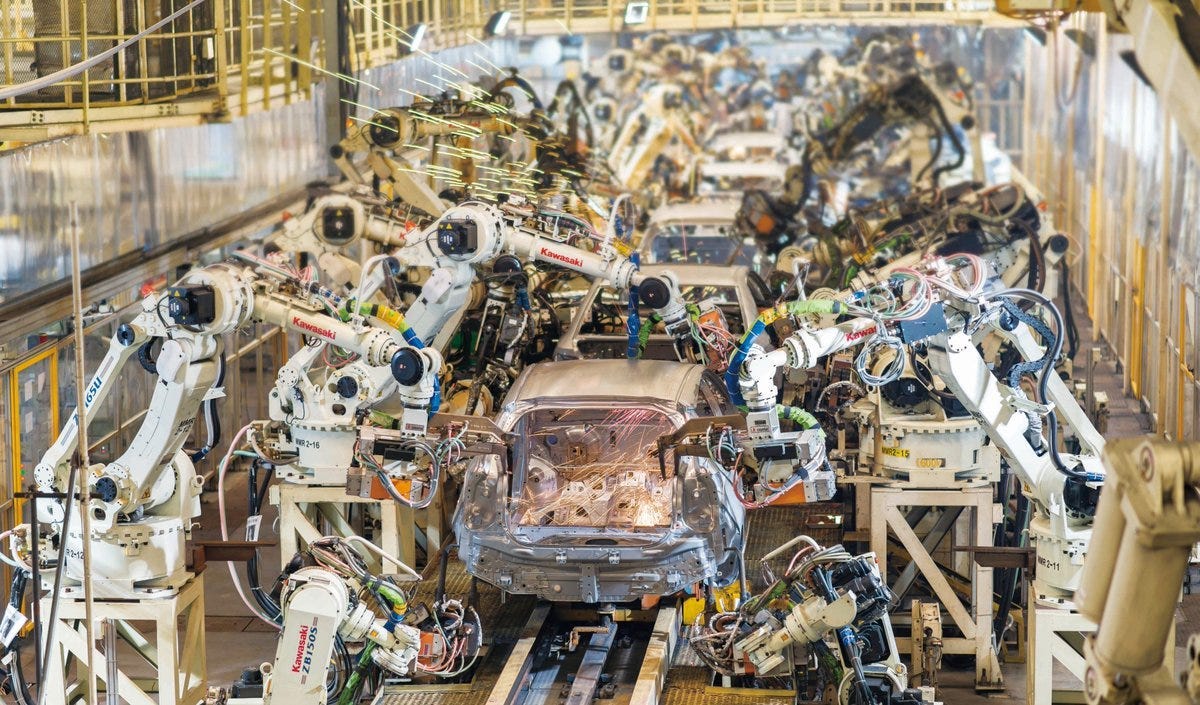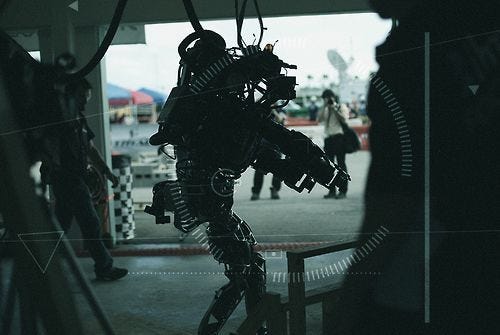Toyoda Automatic Loom Works was an engineering manufacturing company established in the 1920s by Sakichi Toyoda (1967-1930), the son of a successful carpenter hailing from Shizuoka prefecture, in Japan’s Eastern Coast. Its Type G Automatic Loom was the most advanced industrial machine of its kind at the time, a fact which would be enough to grant it a place in Japan’s industrial history.
Nonetheless, Sakichi’s eldest son Kiichiro had other plans for the family business, creating in 1937 an automobile spin-off: the Toyota Motor Corporation. Kiichiro would never learn of his company’s success story, as he died in 1952 shortly after resigning from the company’s presidency. His cousin and friend Eiji Toyoda succeeded him, and along veteran engineer Taiichi Ohno rode the tiger of Japan’s post-war alliance with the US, developing the Toyota Production System that made the company thrive.
The Toyota Production System was a lean manufacturing operational model revolving around a key concept: Just In Time (JIT) manufacturing. The core idea was that production should be perfectly matched to demand, by only supplying products that had been ordered already. Other measures to improve efficiency, productivity and quality would also be introduced to the system, with the aim of reducing “wastes” incurred by the producer. Toyota’s practices transformed the company from a small family enterprise to the behemoth it is today and have been emulated by many other sectors and become a frequent object of academic study.
The selective pressures that made Toyota what it is now were the dire economic conditions of 1950s Japan. There was a not enough cash flow to finance large in-process inventory levels and, most importantly, no raw material. The enormous surplus of workers also meant that there was really no incentive to improve labor efficiency. This situation demanded solutions, such as the innovations in manufacturing doctrine we have already mentioned.
Last week’s post regarding mercenaries in Ukraine ignited some discussion regarding the future of private armies, which is why we have gone on this long digression about Toyota. Japan’s mid-century predicaments could provide a glimpse into the future of the military.
Standing peacetime armies are expensive to build and maintain, and they depend heavily on a special, precious natural resource: a young and healthy male population. Refining this human matter into a combat-ready machine requires equipment, training, and discipline. It usually brings, as an unintended side effect, a set of problems related to overproduction of men capable of purposeful violence. These can be summarized as a volatility of power, of which political instability and organized crime are typical examples. For this reason, most societies can only sustain a small, privileged warrior caste, to which they entrust a bit (or a lot) of political power.
The successive technoeconomic revolutions from the 17th century onwards brought unprecedented cultural and material changes, including explosive population growth and the substitution of caste for class. “Patriotic” conscripted armies, pioneered by Napoleon, were a consequence of the historical anomaly that became apparent during the French Revolution. This exception is known as the Modern Age: a final moment of immense civilizational confidence for the West, thanks to which it colonized and built the modern world.
Such confidence was eroded into oblivion through the great traumas of the 20th century. The nation-state protagonists of this age were replaced by the Great Powers that rose from the 2nd Word War, with their respective spheres of influence. Comprised of countries, corporations and organizations, spheres of influence are characterized by their lack of solidity: like water, allegiances constantly move and shift chaotically. This decentralized, shapeless, dynamic panorama means a return to what was the norm in Europe for much of its history.
Most conflicts before the 18th century were carried out by private or semi-private armies nourished by trained professionals. Military leaders were usually born and bred within the warrior caste. The bulk of the fighting force, however, were professionals troops hired for specific campaigns. Said professionals often belonged to the lower echelons of the same warrior caste, or aspired to enter it through prestige earned in combat. The word soldier, which today encompasses both combat and non-combat roles, owes its Latin root to solidus, the Roman golden coin. This etymological footnote should hint at the profession’s main traditional motivation.
Armies are not only comprised of soldiers. An enormous assortment of camp followers made a living out of providing different services to the fighting men. These people tended to greatly outnumber troops, and usually included their families and servants. The units that carry out these crucial logistic support roles (maintenance, provisioning, nursing) in today’s militaries are the sociodemographic equivalent of said camp followers, and have very similar makeups and extraction. The derisive comments about the armed forces as a “government jobs program”, common in some military circles, reflect vestigial attitudes of the warrior caste towards this demographic.
The worsening population crisis and a general lack of fitness are too reasons for this. The raw material has simply become more scarce. The technical superiority of Western nations over their foes in the last few decades has also been a poor incentive for warrior-breeding, much like Japan’s excess of laborers did not encourage efficiency in the 1950s. One could think that a pervasive, herbivorous mentality is also to blame for the limited availability of enfants de la patrie fit and ready for war. Even Russians, those allegedly war-like people, have shown an unexpectedly lukewarm attitude to the recent war.
This meekness is not exactly natural. The military as a “government jobs program” is not a mistake, but an actively promoted reality. We have already mentioned the disruptive potential of an excess of warrior types. This is not the case for an army of camp followers, who are quite content with making a living while being thanked for their service, and tend to stay loyal to the regime that employs them.
Consolidating power in a globalized world of liquid spheres of influence requires workers, preferably if they are disciplined, malleable, and not very dangerous. Separating the Military As An Organization from the Military As A Political Function is a rational measure taken by Power to protect itself from the warrior castes. With this danger in mind, the transition to “lean recruitment” is a no-brainer.
In other words, the Military As An Organization will try to discourage warriors from enlisting. The Military As A Political Function, in turn, will be outsourced to mercenaries, fostering efficiency and competence, and avoiding wasteful leaks of power from the ruling class towards the warrior caste. The Military Industrial Complex, which we have deliberately not mentioned until now, will stay equally profitable, as it’s what justifies keeping the Military As An Organization in the first place.
The liquid character of mercenary armies swimming in a globalized market is the ideal tool for the world that is being built. Private Military Companies are the equivalent of Just In Time manufacturing: efficient and always ready for action. You acquire only the armies that you are going to use, and don’t waste resources and potential on storing them, festering and conspiring in the barracks. In the future, the warrior caste will prefer service in the private armies that are already becoming common.
Power would also have it this way. For a cosmopolitan, anomic ruling class used to the immediate, Internet-powered satisfaction of needs and desires, the idea comes more naturally than a patriotic military. Private use of force has a bright future as an industry. The question that remains is what will happen when such a promising industry inevitably grows beyond its assigned role.










I've been under the impression that most mercenaries start as official military and then find their way into other employ after "graduating" so to speak. Is that accurate? Maybe a US-skewed perception?